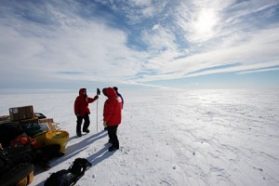In Antarctica watch the heat (and your step)
Behind the scenes: news detective
By Douglas Fox

The tortures of Antarctica include not only cold, but also heat. I discovered it nearly every morning.
As I woke in my tiny tent, in the middle of a million square miles of ice, I struggled to get my clothes off quickly enough. The thermometer hanging in my tent often read over 30ºC. One time it even said 37ºC!
It shows that part of what keeps Antarctica cold and frozen is its color. Because it is white, it reflects most of its sunlight, and heat, back into space. But our tents were bright red, and in the 24-hour summer sunlight they absorbed plenty of heat (and my own body heat probably also warmed the tent).
Heat can be one of the surprising annoyances of working in Antarctica — and then come the dangers: huge cracks in the ice, called crevasses. They form as the ice stretches and bends over bumps in the rock below.
Some crevasses are 20 feet across and hundreds of feet deep. They lay hidden under thin crusts of snow. A person or a snowmobile can fall through that crust and into the crack. If it happens, broken bones are likely. Death is possible. Help, if we have to call for it, could be several days away.
So we do everything we can to avoid crevasses. For months before our trip, Tulaczyk and Pettersson looked at satellite photographs of the ice in order to find crevasse fields and plan our snowmobile routes around them.
And each time we drove to a new place, we wore climbing harnesses and traveled with our three snowmobiles roped together. We also kept a sled roped between the first two snowmobiles. If the front snowmobile falls in a crevasse it will drag the rest of us forward — until the sled reaches the lip of the crack. The sled is supposed to stop all of us from falling in. That’s the plan, at least.
We never had to test this last-ditch survival plan, but we did discover a couple of unknown crevasse fields during our time on the ice. In one place, a series of narrow cracks — six inches to a foot and a half wide — ran across our snowmobile tracks. The widest of these cracks may have been big enough to swallow a person, but probably not a whole snowmobile. So we continued to drive over this crevasse field. But Pettersson warned us never to stop while crossing it — let alone step off our snowmobiles — and not to let our speed drop below 20 kilometers per hour.
The other crevasse field that we discovered was scarier. As Tulaczyk, Pettersson and I drove toward Lake Conway, another subglacial lake, we encountered a crevasse 10 feet across and hidden under just two feet of snow. Crevasses are often 50 to 100 times deep as they are across, so this crevasse could have been 500 to 1,000 feet deep. It’s likely that our snowmobiles would have plunged in had we tried to drive across it. And where there’s one crevasse, there’s usually many more lurking beneath the snow.
Tulaczyk and Pettersson decided to abandon our drive to Lake Conway, and to install the GPS box that we were carrying in another area of interest, a channel connecting two lakes. Research in Antarctica isn’t just about doing good experiments. It’s also about making good decisions — and surviving to return the next year.







